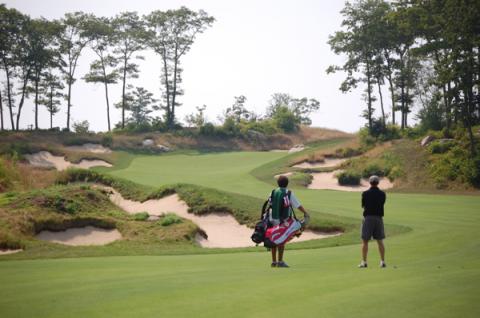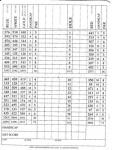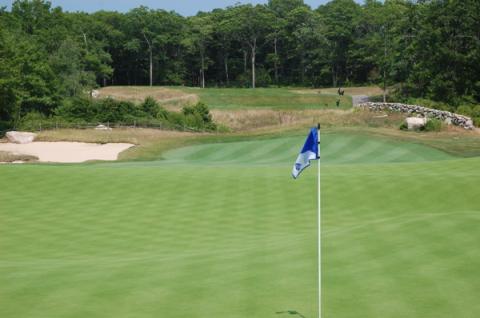
Visually and strategically, the 9th at Shelter Harbor is the epitome of a great par 5, with a lay-up second shot that demands thought and care.
by Tim Gavrich
On Monday, my father and I had the pleasure of playing the Shelter Harbor Golf Club in Charlestown, Rhode Island, during a fundraiser outing for my former high school. Shelter Harbor is challenging, varied in its shot-making requirements, and a great deal of fun. I have been struggling the rest of this week to think of where it ranks among the few other great courses I have played. Only Newport CC, Yale GC, and Pinehurst No. 2 stand ahead of it in my mind. I would rank Shelter Harbor ahead of two other outstanding courses I have played -- Cuscowilla, a highly ranked course in Georgia by Coore & Crenshaw, and TPC River Highlands in Connecticut, one of the PGA players' favorite courses.
One of the most important aspects of golf course architecture is a good mix of playability and difficulty. These may seem like opposite characteristics, but when they come together, as they do at Shelter Harbor, the result is a top-notch course.
Higher handicap players will appreciate the wide fairways on the course although they may not feel comfortable with some of the forced carries (e.g. the short, two-shot par 4 13th hole, which requires the tee shot to clear an expanse of wetlands). But pains seem to have been taken via local rules to minimize the penalty. (On the 13th, the drop area across the wetlands affords a shot to the green, so that the player can easily save bogey, if not make a one-putt par.) The trouble off Shelter Harbor's fairways is often severe, coming in the form of bunkers out of which the only escape is often a wedge back to the fairway. In an age in which bunkers have been leveled to the point that many don't quite fit the definition of "hazard," Shelter Harbor's sandy spots are best admired from afar (and by camera, as the accompanying photographs attest).
comfortable with some of the forced carries (e.g. the short, two-shot par 4 13th hole, which requires the tee shot to clear an expanse of wetlands). But pains seem to have been taken via local rules to minimize the penalty. (On the 13th, the drop area across the wetlands affords a shot to the green, so that the player can easily save bogey, if not make a one-putt par.) The trouble off Shelter Harbor's fairways is often severe, coming in the form of bunkers out of which the only escape is often a wedge back to the fairway. In an age in which bunkers have been leveled to the point that many don't quite fit the definition of "hazard," Shelter Harbor's sandy spots are best admired from afar (and by camera, as the accompanying photographs attest).
Another prerequisite for architectural greatness is interest and variation on and around greens. The world's great golf courses - the Pine Valleys, Augusta Nationals, and Oakmonts - are renowned for their superb greens. I cannot think of more than a few more varied, challenging, and fun sets of 18 greens than those I played at Shelter Harbor. In addition to being exquisitely maintained (not surprising for a club whose initiation fees are in the neighborhood of $125,000), these greens reward thoughtful shot making and creativity. Many of them have wild undulations that allow the player to move the ball around the green in interesting ways. For example, some slopes on Shelter Harbor's greens have "backboards" behind the pins that give you an option to hit past the pin and bring the ball back. The greens were fast, perfectly cut and held every well-struck shot. I could spend hours on and around these greens.
greens. I cannot think of more than a few more varied, challenging, and fun sets of 18 greens than those I played at Shelter Harbor. In addition to being exquisitely maintained (not surprising for a club whose initiation fees are in the neighborhood of $125,000), these greens reward thoughtful shot making and creativity. Many of them have wild undulations that allow the player to move the ball around the green in interesting ways. For example, some slopes on Shelter Harbor's greens have "backboards" behind the pins that give you an option to hit past the pin and bring the ball back. The greens were fast, perfectly cut and held every well-struck shot. I could spend hours on and around these greens.
I enjoyed every hole at Shelter Harbor, but two stand out as being particularly excellent. Hole #4, a long par three, is one of the best one-shot holes I have ever played. The hole appears to be architects Dr. Michael Hurdzan and Dana Fry's interpretation of a Biarritz hole, a long par three that plays to a huge, deep green with a deep trench running sideways through the middle. Those who have played Yale Golf Club in Connecticut and its 9th hole will recognize the classic Biarritz. The green on Shelter Harbor's 4th hole is 62 yards from front to back and a larger-than average Biarritz trench runs sideways across the middle third of the green. This allows for pin placements in the trench; trenches at most Biarritz holes are not wide enough for that. There is also a pronounced slope at the rear-middle of the green that allows a player whose ball has found the bottom of the trench (a player such as myself) to putt well beyond the hole in the hopes of the ball rolling up the slope and back down towards a hole located near the base of that slope. This is a great example of the creativity made possible by contours in the greens at Shelter Harbor.
its 9th hole will recognize the classic Biarritz. The green on Shelter Harbor's 4th hole is 62 yards from front to back and a larger-than average Biarritz trench runs sideways across the middle third of the green. This allows for pin placements in the trench; trenches at most Biarritz holes are not wide enough for that. There is also a pronounced slope at the rear-middle of the green that allows a player whose ball has found the bottom of the trench (a player such as myself) to putt well beyond the hole in the hopes of the ball rolling up the slope and back down towards a hole located near the base of that slope. This is a great example of the creativity made possible by contours in the greens at Shelter Harbor.
The par five 9th is another fantastic hole. Two bunkers in the center of the fairway serve a more psychological than practical purpose - they make the fairway seem narrower than it is. A drive just left of these bunkers can put the player in position to blast a fairway wood uphill to a green tucked up around a corner below Shelter Harbor's magnificent Cape Cod-style clubhouse. Bunkers farther down the fairway punish any casual lay-up shot, and a large boulder guards the left edge of the fairway about 125 yards from the green and so too does one just in front of the green on the right. If the player chooses (successfully) to be more aggressive with the lay-up shot, he will be rewarded with a more straightforward pitch up the length of the green. The 9th green itself is two-tiered, with sideboards and backboards to reward creative wedge play (or a shot hit to pin high but slightly offline). The 9th is definitely a birdie hole that can get away from a player who does not give thought to each of his first three shots.
lay-up shot, and a large boulder guards the left edge of the fairway about 125 yards from the green and so too does one just in front of the green on the right. If the player chooses (successfully) to be more aggressive with the lay-up shot, he will be rewarded with a more straightforward pitch up the length of the green. The 9th green itself is two-tiered, with sideboards and backboards to reward creative wedge play (or a shot hit to pin high but slightly offline). The 9th is definitely a birdie hole that can get away from a player who does not give thought to each of his first three shots.
If there is any drawback to Shelter Harbor's layout, it is the lack of a drivable par four. Hole 7 is an interesting par four in its own right, with a tiny green protected by steep slopes short and long. Even though it is listed at 336 from the members' tees and plays about 40 feet downhill, it is not as reachable as the website description (www.shgcri.com) indicates. It is a good hole; it just is not reachable from the tee for even the longest bangers.
Shelter Harbor is a fantastic golf course from beginning to end. Even though it is only three-years old, I would venture to say that it is one of the best golf courses built in New England in recent memory and may challenge for best-in-Rhode Island honors in time (a post held by the renowned Newport Country Club).
Those who have the opportunity to play Shelter Harbor will experience an unforgettable day of golf.

From the tee (above), the 4th green is easy to hit but woe be to anyone whose ball comes to rest in the mid-green trench (see below) when the pin is elsewhere.




